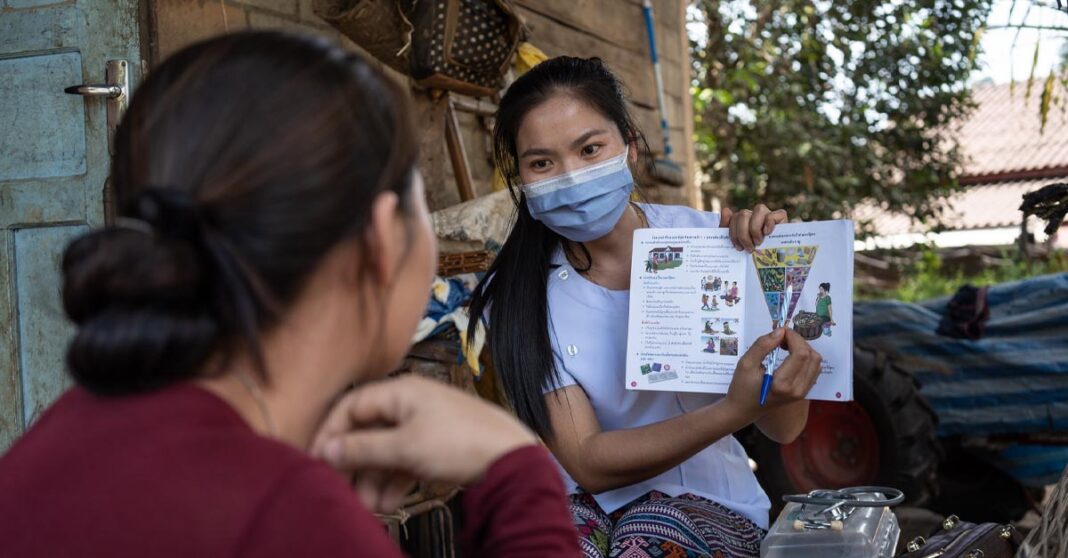Today we mark World Health Day and the 75th anniversary of WHO and have a chance to reflect on the gains secured, and what is needed to sustain and build on these, writes Dr. Ying-Ru Lo, WHO Representative to Laos in an Op-ed.
The grave threat of malaria has almost been eliminated in Laos. Cases here have fallen from an estimated 460,000 in 1997 to 2,305 last year.
In 2017, the National Health Insurance scheme was rolled out to all provinces (except Vientiane Capital), aiming to provide access to healthcare for everyone without financial hardship.
And, the most recent and memorable achievement, a strong, fast whole-of-country response to COVID-19 ensured one of Asia’s lowest losses of life.
Ongoing challenges, and our shared drive for nothing less than health for all, meaning it can be easy to forget the achievements of decades of hard work.
In Laos, since joining WHO in 1950, this work has meant supporting patients, their families, communities, healthcare workers, and the government to help achieve these impressive milestones.
These could not have been achieved without tireless efforts from health workers and officials behind the scenes, national leadership by the government, and continuous support from development partners. I’m proud WHO has played a lead role.
As we look forward and decide the actions necessary to sustain and build on these achievements – particularly when Laos faces inflation and rising costs, declining health budgets, and emerging threats like climate change – we must remember to look back.
The challenges we face now may seem insurmountable, but these historic problems likely seemed equally impossible.
Four areas of remarkable health progress in Laos
As late as the 1990s, malaria cases were in the hundreds of thousands. The resulting disruption to employment and education brought significant economic consequences. Thousands of lives were lost, and tens of thousands were devastated by the disease’s long-term impacts.
Immense progress by the Ministry of Health and partners – focusing on village-level treatment and surveillance – means Laos is on track to eliminate the deadliest of the five malaria parasites by 2024.
A second area of progress is maternal and child health.
In 1978, a tragic 218 children out of every 1,000 would pass away by the age of five. In 2020, following massive, continued investments and prioritization by the government and partners, this has fallen to 44. This is an enormous achievement.
Over the same period, the number of pregnant women who died per 100 000 live births fell 78.7%, from 579 in 2000 to 126 in 2020 – one of the fastest falling rates in the world.
Improvements to the national health system are another area of dramatic change.
In 2016, Laos rolled out the National Health Insurance scheme to all provinces except Vientiane Capital. It aims to ensure equitable access to health care without financial hardship, particularly for the poor. This is remarkable progress towards health equity, and based on recent analysis, the scheme has positively impacted financial protection and access to care.
Finally, the government has undertaken commendable work on tobacco control.
In 2009, Laos introduced the first National Tobacco Control Law, followed by a 2010 Prime Minister’s decree banning tobacco advertisement, promotion, and sponsorship. In 2021, Laos became one of 30 countries to ban e-cigarettes and other new nicotine products.
Now is the time to accelerate progress
These are outstanding achievements — but there is more to be done.
Momentum and lessons from the COVID-19 response create an opportunity for Laos to continue strengthening its capacity to prepare and respond to public health emergencies.
The remaining malaria cases are almost entirely in remote, hard-to-reach communities. Reaching the unreached will be tough, and we need to ensure similar progress on tuberculosis and HIV.
Mortality rates for children under 5 and mothers lost during childbirth are still higher than the global average.
The National Health Insurance scheme is a powerful tool, but gaps remain.
Finally, tobacco use remains an immense burden in Laos, killing approximately 7,000 children, women, and men each year and costing LAK 3.6 trillion. Contributing to this are the lowest tobacco tax rates in the ASEAN region.
The hard-earned gains can be sustained and gaps addressed, but only with committed action that also accounts for new threats: COVID-19’s socioeconomic impacts and disruptions to routine vaccination, global economic challenges, and climate change.
Addressing them will require sufficient funding for health. The funding gap is too large – including for the National Health Insurance scheme and essential health services.
The consequences of underfunding could be dire, impacting the availability, accessibility, and quality of healthcare services. But this scenario is not inevitable. Four key actions would sustain and build a stronger, healthier Laos.
First, development partners must sustain and increase funding to maintain essential health services during this period when health budgets are insufficient. Indeed, we urge partners to consider Laos for emergency funding — the economic situation here is challenging.
Second, to be effective, development partner efforts must closely align with the Ministry of Health’s priorities, to strengthen the country’s health system, support the delivery of essential health services, and respond to community needs.
Third, we urge an increase in the national budget allocation to health as pledged at the National Assembly from 6.7% to at least 9%. To be sustainable, this should be direct government contributions, not donor contributions.
Finally, we must focus on increasing revenue for things that matter by ensuring compliance of taxes on alcohol and tobacco, as well as eliminating tax exemptions and increasing taxes for these harmful products.
These steps require the government to take decisive action, directing health development funding to best serve people.
During the pandemic, we have seen that without health, we cannot achieve national development goals.
While the task may seem enormous, the history of health gains in Laos is an excellent reminder that it can be done.
The views and opinions expressed in this article are those of the author and do not necessarily reflect the position of the Laotian Times.



